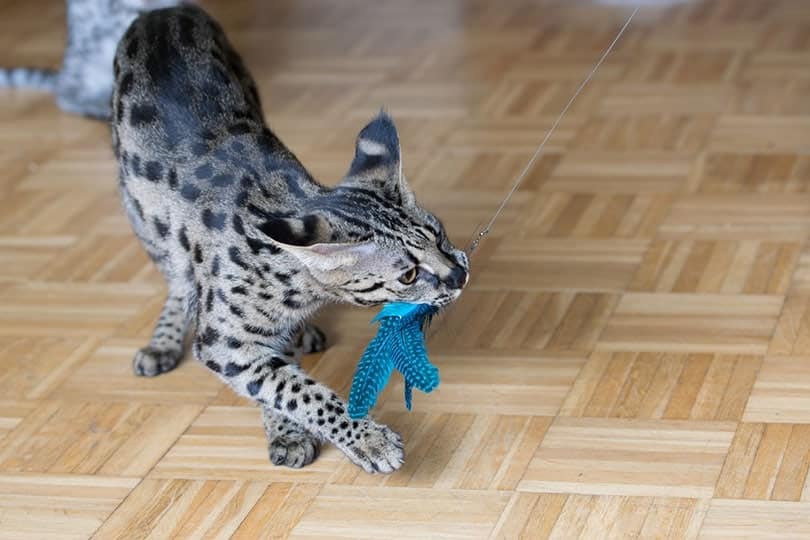Click to Skip Ahead
The Savannah cat breed is unique in many ways. An average adult Savannah cat can grow up to about 17 inches tall and weigh approximately 25 pounds, depending on the filial generation. It’s no surprise a Savannah cat was bestowed the “tallest living domestic cat” title by the Guinness World Records1. Another unique characteristic of this breed is its ancestry. Savannah cats are hybrids that resulted from crossbreeding an exotic African serval wild cat and a Siamese domestic cat.
Due to their exotic wild genes, there are laws about owning Savannah cats in almost all US states. So, are Savannah cats legal in Illinois? Yes, Savannah cats are legal to own in Illinois. But there’s a lot you should know about what the law says. Keep reading.
Can I Own a Savannah Cat in Illinois?
Absolutely. Illinois is one of the few US states that allow individuals to own Savannah cats of all filial generations. According to the amended Illinois Dangerous Animals Act, no individual can care for, harbor, act as custodian of, keep, or maintain in their possession any dangerous animal or primate1.
This is unless the dangerous animal is kept at a properly maintained zoological park, college or university, federally licensed exhibit, circus, hound running area, scientific institution, research laboratory, veterinary hospital, or animal refuge in an escape-proof enclosure.
Since Savannah cats aren’t on the list of dangerous animals stated in this law, it is legal to own one in Illinois. However, like every other US state, Illinois has several laws that govern how animals, especially domesticated ones, ought to be cared for. A good example is the Humane Care for Animals Act, which prohibits acts of cruelty against animals2.
Another one is the “IL – Cruelty, reporting – 5/11.8. Cross-reporting.” This law gives Investigation Specialists, Intact Family Specialists, and Placement Specialists employed by the Department of Children and Family Services the right to report any households they believe are abusing animals3.

Why Are Savannah Cats Illegal in Some States?
One of the main reasons why Savannah cats are illegal in some US states is because it is a wild cat hybrid. Since Savannah cats have exotic wild cat genes, some US states consider them to be similar to actual feral cats. Therefore, these states include Savannah cats in the list of exotic wild cats they prohibit people from owning.
Another reason that may have contributed to the prohibition of Savannah cat possession in some states is that not all cat associations recognize this breed as a domestic one. For instance, the Cat Fanciers’ Association (CFA) doesn’t recognize the Savannah cat breed as a domestic breed.
Caring for a Savannah Cat in 3 Steps
Since Savannah cats are legal in Illinois, it’s best to know how to take care of them if you want to own one. So, are Savannah cats high maintenance? The answer is no. With that said, here are several tips on how to take care of a Savannah cat.
1. Exercise
It’s recommendable to provide your Savannah cat space to exercise its limbs. One of the physical characteristics of this breed is long legs, so it’s best to allow them to exercise them. Savannah cats also love walks (one of the traits that makes them unique), so you can take your feline companion out for occasional walks.

2. Grooming
Typically, Savannah cats have short fur coats (one of the reasons they are low maintenance,) so you can brush your cat’s fur coat weekly to avoid hairballs. Also, trim their nails weekly to prevent them from getting too long and painfully breaking off when caught in the carpet or furniture.
3. Diet and Nutrition
Savannah cats require a combination of wet or dry food and raw or cooked meat. If you prefer giving your cat dry food, then it should be more of a whole-protein diet.
Don’t forget to give your feline companion fresh water to drink regularly. However, keep in mind that Savannah cats love water, so your cat will most likely play with the water you give them rather than drink it. So, it’s advisable to use a cat water fountain to provide your cat with drinking water.

Final Thoughts
The issue of Savannah cats being legal in all US states is still a controversial one, but since they are legal to own in Illinois, you have nothing to worry about. One thing you need to keep in mind is that these kitties cost a fortune.
Typically, Savannah cats have a price tag of between $1,000–$20,000 depending on the sex and filial generation. So, be prepared to dig deep into your pockets if you’re looking to buy one.
- Related Read: Are Savannah Cats Legal in Massachusetts?
Featured Image Credit: Kseniya, Shutterstock











